
1 Display Post Title

Use this option to turn On or Off the display of post title.
2 Enable Post Link

Lets you enable or disable the post link

1 Display Post Title

Use this option to turn On or Off the display of post title.
2 Enable Post Link

Lets you enable or disable the post link
Double-click the content and a menu bar, as shown below. It allows you to edit the content of rows and columns. Let us discuss the functions of these options for editing and formatting the content.

1 File Menu
![]()
![]()
The File Menu consists of general formatting options such as Undo, Redo, Bold & Italic styles, Alignment styles, Bulleted list, Numbered list, Left/ Right Indentation, and Inset/Edit link. You can choose accordingly.
2 Edit Menu
![]()

Edit menu contains general editing options such as Cut, Copy, Paste, Undo, and Redo. You can select as required.
3 Insert Menu
![]()

The Insert menu includes the options to insert links, special characters. Media, Read More tag, and Page Break.
4 Format Menu
![]()

Format Menu consists of the most commonly used text formatting options such as Bold, Italic, Underline, Strikethrough, Superscript, and Subscript.

1 Add a Row
![]()
With these controls, you can add a row with predefined columns in your page.
2 Edit Source Code
![]()
Click on this button to view the source code of the page and edit the same.
3 Preview
![]()
Allows you to preview the page in Desktop, Tablet and Mobile mode. To change the view mode, click the ” Desktop” button and select the mode as needed.
4 Move the Row
![]()
Use this to move the row to a desired place.
5 Customize Row Style
![]()
Lets you customize the row style. By clicking this control, you may add your own style class in the source code.
6 Add a Column
![]()
Use this to a column in the row.
7 Delete Row
![]()
Lets you delete the row.
8 Move Column
![]()
Use this to move the column from one place to another.
9 Increase/ Decrease Width of Column
![]()
The option lets you adjust the width controls of the column. You may decrease the width of the column by clicking “-” and increase the width with “+”.
10 Customize Column Style
![]()
Use this to customize the column styles. By clicking this control, you may add your own style class in the source code.
11 Delete Column
![]()
Deletes the column.
12 Add Columns
![]()
You can add a column inside the column.
While Adding/Editing a page in WordPress, you’ll see Page Options at the right side of the screen. Let us discuss about these options here.

1 Show/ Hide Page Title

Use this option to Show/Hide the title of the page on your website.
2 Show/ Hide Footer

Lets you show/hide the footer of the page.
3 Change Header Background Style

Use this to choose a preferred style for the header background. There are three options for choosing the style – Fill, Horizontal Fill, Vertical Fill.
4 Disable Header Repeat

Use this to enable/disable the header image repeat.
5 Upload Header Background Image

Lets you upload an image to apply to the header background.
One of the best features is that customizing TemplateToaster’s theme is extremely easy, even after installation. You can find an additional tool on the sidebar of the admin dashboard, under the name “Theme Options”. These theme options give you the flexibility to change some elements of your theme. Let us have a look at these theme options.
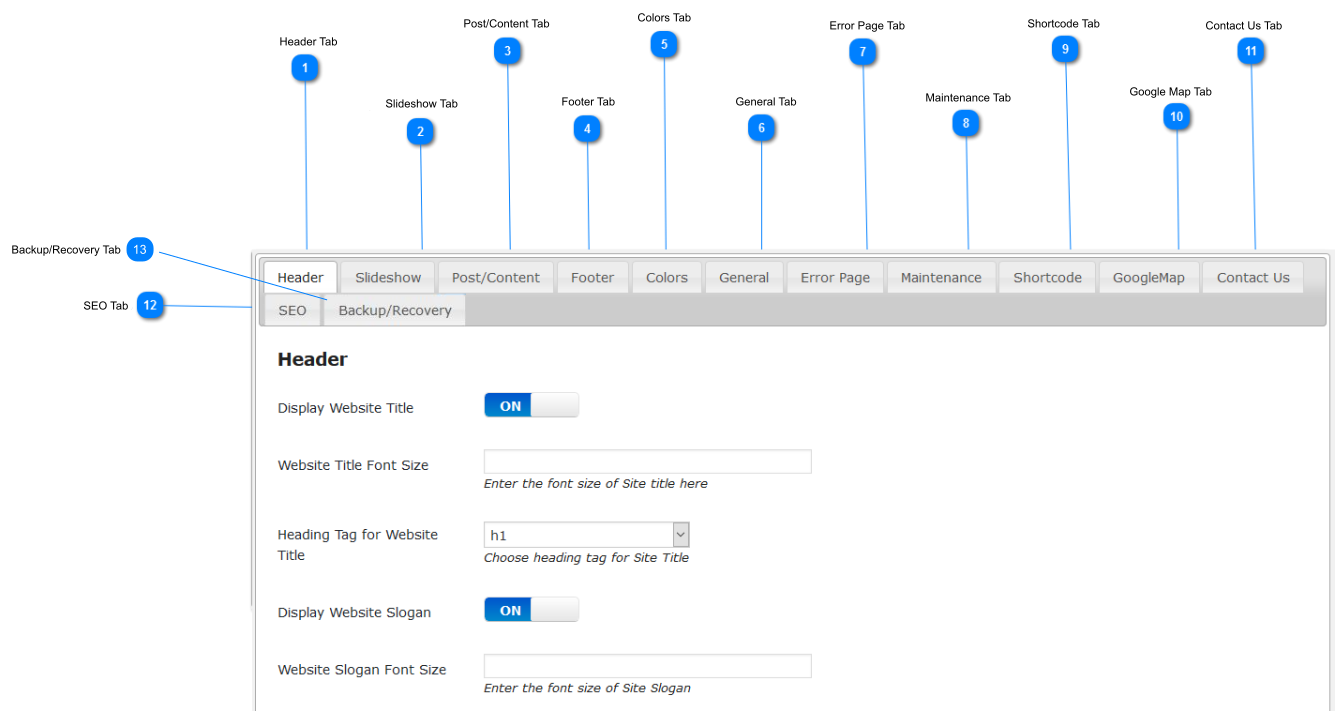
1 Header Tab
This tab allows you to customize your site logo, site slogan, social media icons, even after export. You can show/hide a logo or icons. It also allows you to set a new logo image or social media icons. Moreover, you can even change the height, width or link to all these images.
2 Slideshow Tab
![]()
This tab shows you various options of Slideshow for your theme. It allows you to replace the images used in the slideshow by uploading new ones. And the best part is that you can do it even after installing the theme.
3 Post/ Content Tab
![]()
This tab consists of the options for customizing the post settings.

Number of Featured Posts –
You can mention the number of featured posts to display on the home page of the site.
Number of Columns –
You can specify in how many columns to show the featured posts.
Show Breadcrumb on the Page –
Breadcrumbs is basically the type of text-based website navigation that breaks the site into links of categories and sub categories. Breadcrumbs makes site navigation easier while allowing major categories of information to be linked in a sequential order. So the breadcrumb navigation is displayed to the user. This makes it easier for the users to easily navigate between the pages.
Select the “ON” option, if you want to display the Breadcrumbs. Otherwise select “OFF” option to hide the Breadcrumbs.
Show Breadcrumb on the Post –
You can show/hide the breadcrumb on the post as well. Simply select this option.
Breadcrumb Prefix –
Set a breadcrumb prefix using this option.
Breadcrumb Separator –
You can set a desired separator on the breadcrumb using this option.
4 Footer Tab
![]()
It includes following options to customize the Footer:
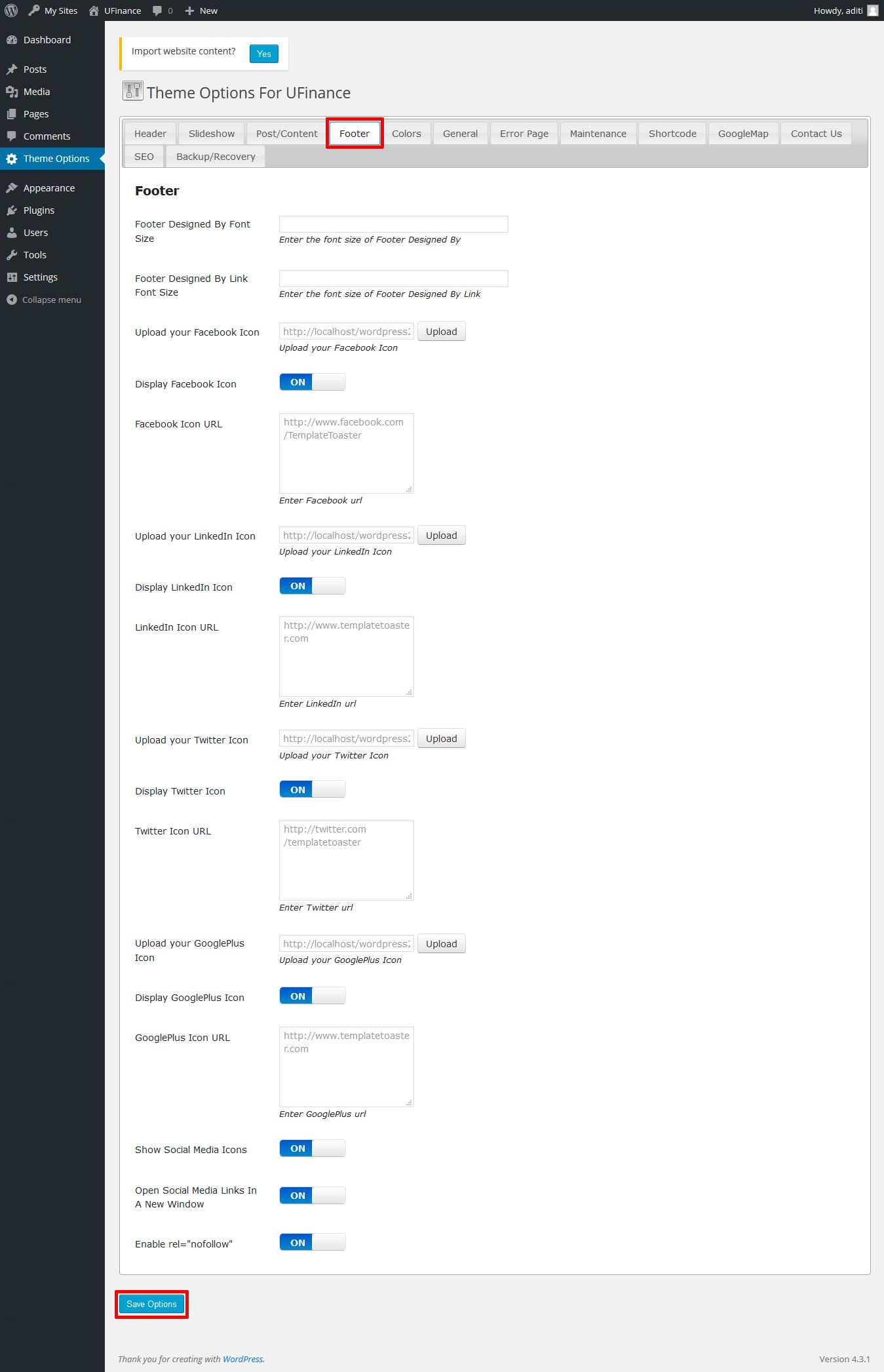
Footer Copyright Text –
Use this to add/edit Copyright Text in the footer.
Footer Copyright URL –
Place the relevant copyright URL on Copyright Text in the footer.
Display Footer Copyright –
Select ‘On’ to display the Copyright Text in the footer. Otherwise you can keep it ‘Off’ to hide.
Footer Copyright Font Size –
Enter the required font size for the Footer Copyright Text.
Footer Designed by Font Size –
Enter the required font size for Designed by element in the footer.
Footer Designed by Link Font Size –
Enter the required font size for Designed by Link Text.
Facebook Account Configuration-
You can upload a custom Facebook Icon and link it with your Facebook account. If you don’t want to display Facebook Icon in the footer, you can turn it OFF and vice -versa.
LinkedIn Account Configuration-
You can upload your desired custom LinkedIn icon in the footer. Then, specify the URL of the LinkedIn account to link with the icon. If you don’t want to display the Icon in the footer, you can turn it OFF and vice -versa.
Twitter Account Configuration-
You can upload a custom Twitter Icon and link it with your Twitter account. If you don’t want to display Twitter Icon in the footer, you can turn it OFF and vice -versa.
Google + Account Configuration –
You can upload a custom Google+ Icon and link it with your Google+ account. If you don’t want to display Google+ Icon in the footer, you can turn it OFF and vice -versa.
5 Colors
![]()
You can change the colors of some elements of the website, which are shown below:
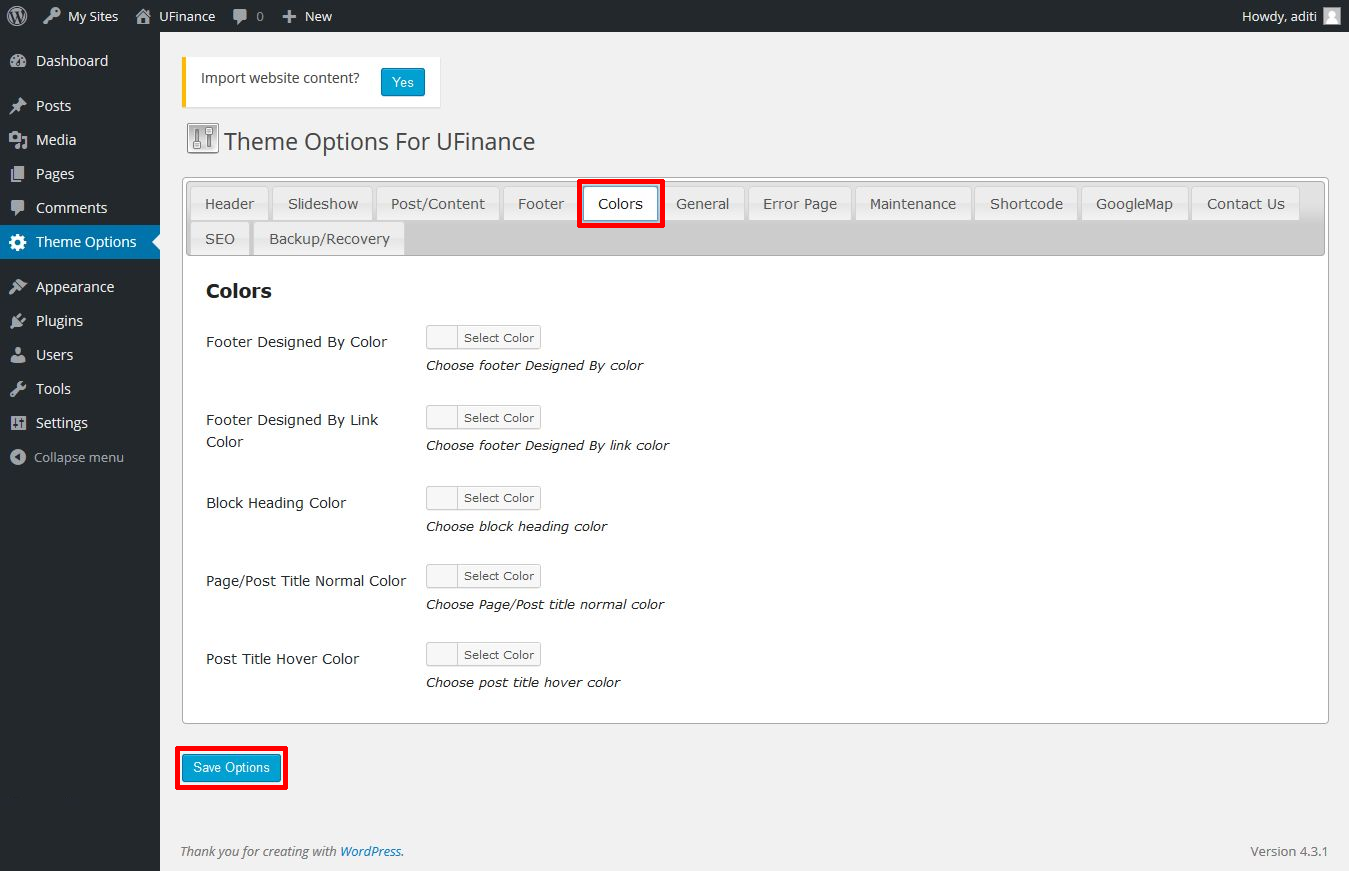
6 General Tab
![]()
This tab offers you the options for general elements on your website. Use this tab, if you want to enable/disable elements like, Google Analytics, Page Title, Post Title, Navigation, Next/Previous link, Comment display, Avatar, Back To Top Button etc.
7 Error Page Tab
![]()
This tab gives you the options for configuring error page settings like, redirect to home page if Error page occurs, displaying error message, and image, etc.
8 Maintenance Tab
![]()
You can make use of this tab if your website is going in maintenance mode. You can write the title and content for the maintenance mode page. And apply an image in the background, using the options available.
9 Shortcode Tab
![]()
In this tab, most of the commonly used shortcodes are available. From this tab, you can get the shortcodes for Google Docs Viewer, Google Map, Related Posts, Google AdSense, Google Chart, Tweet Me Button, YouTube, Private Content, PayPal, Login Form, Custom Menu, Archives, Contact Us Form, Calendar, Categories, Links, Meta, Pages, Recent Comments, Recent Posts, RSS, Search, Tag Cloud and Text.
10 Google Map
![]()
This tab has the option that lets you add Google Maps on your website. You need to simply provide few details.
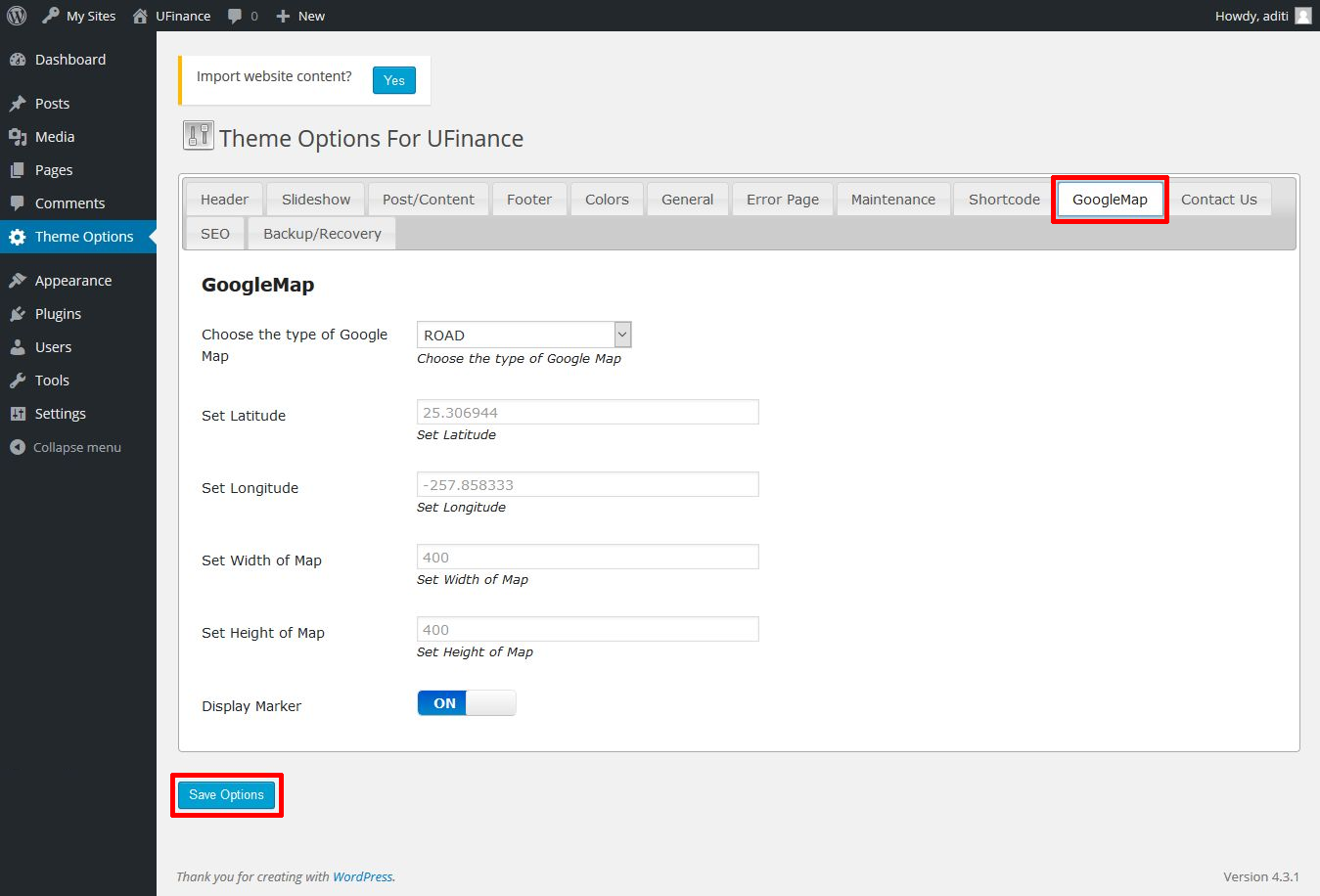
11 Contact us Tab
![]()
This tab lets you customize the contact form. You can specify Public and Private key for Google Captcha, customize Error/ Success message and can also add more fields in the form as needed.
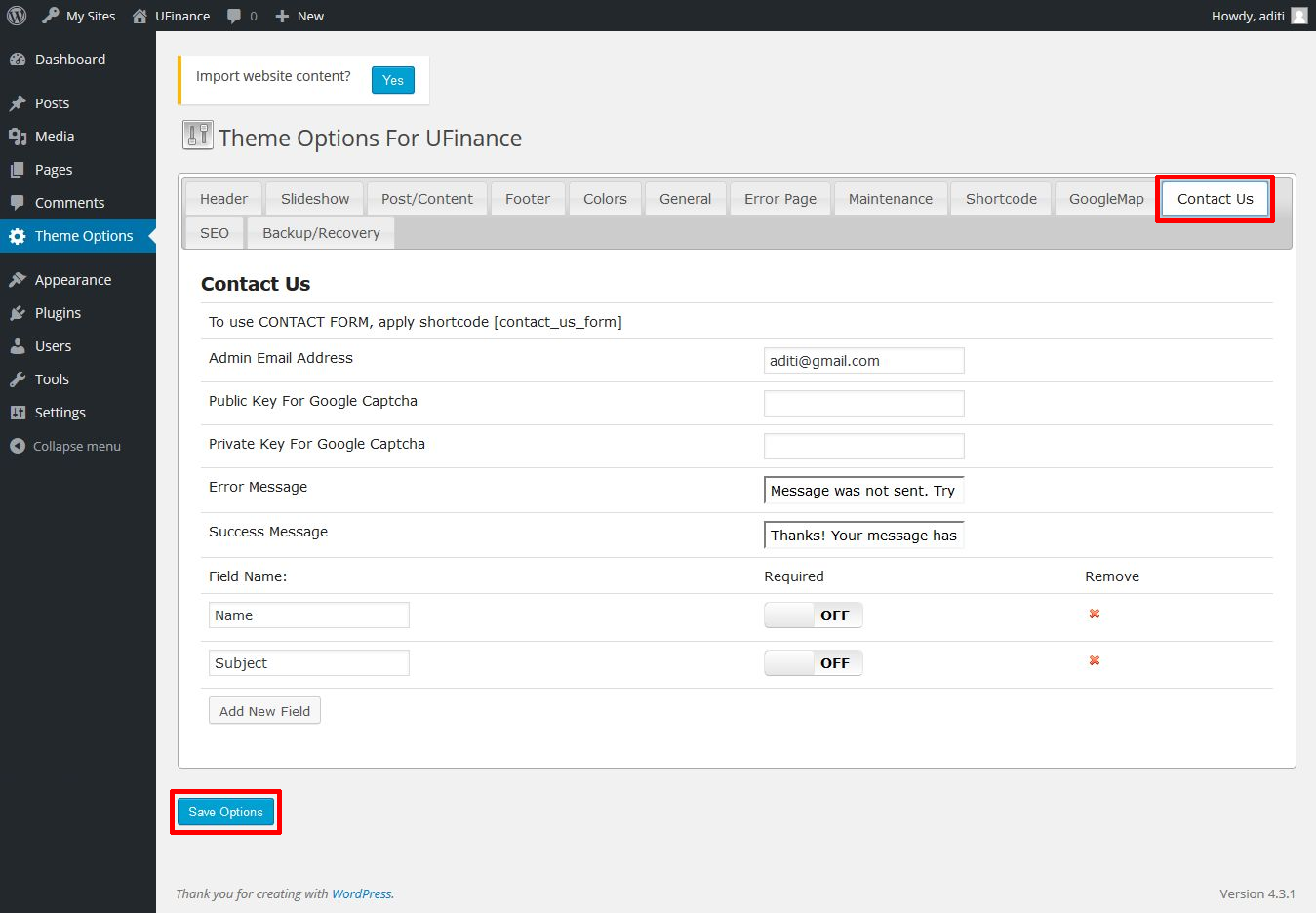
12 SEO Tab
![]()
This tab has some important SEO options for your website, which are divided into sub-tabs.
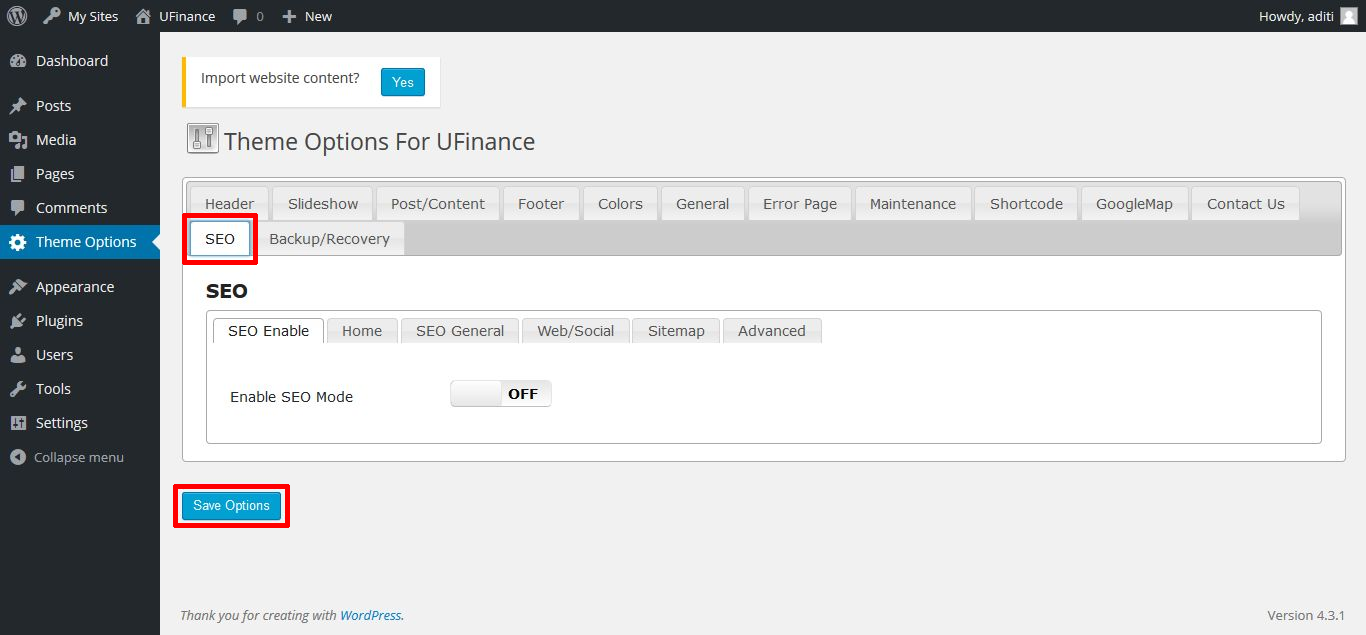
SEO Enable –
It is up to you whether you want to enable the SEO mode or not. You can choose to enable or disable this option.
Home –
From the home sub-tab, you can specify the Title, Meta Description and Keywords of the Homepage. Besides this, you can also select the Title formats of Page, Post, Category, Date Archive, Author Archive, Tag, Search and 404.
SEO General –
This sub-tab has options to ON (enable)/ OFF ( disable) general SEO features, such as use of Meta Keywords, use of categories as keywords, use of tags as keywords, auto generate descriptions, set No-Index for all pages, set No-Index for all posts and set No-Follow for all pages.
Web/Social –
Through this sub-tab, you can verify your website with Google Webmaster Tool, Bing Webmaster Tool and Pinterest Webmaster Tool. And, you can also provide default Google Plus profile, which is required for Google Analytics.
Sitemap –
You can see the sitemap of your website from this tab. Also, you can decide whether you want to include Page Type and Post type in the sitemap or not.
Advanced –
This sub-tab gives you the advanced SEO options. Those options allow you to turn ON/OFF the use of No-Index/ No-Follow for different archives, like Date Archive, Author Archive, Tag Archive, Category Archive, Search Archive. And, you can also define additional Post and Page headers.
13 Backup/ Recovery Tab
![]()
Backup and Recovery is an important feature of TemplateToaster. You need to give the FTP information and an Email address for backup storage and to create an automatic backup schedule. The backup of your website will be created automatically according the schedule you’ve made. You can choose automatic backup interval according to your preference, which could be as short as 10 minutes or as long as a week. Moreover, you can also choose the files to include in the backup and the ones to exclude. Similarly, while restoring the backup, you can select the type of files to restore and the ones to refrain from restoring.

Follow these steps to upload your theme on WordPress:
STEP 1: Log in to your administrator dashboard.

STEP 2: On the left sidebar of the dashboard, navigate to Appearance –> Themes. Now, click Add New.

STEP 3: Once you click on the Add New button, you will see the next screen as shown below. Click on the “Upload Theme” option from here.

STEP 4: Now you can Browse your theme and press the “Install Now” button.

STEP 5: After successful installation, you can Activate the theme on your website.

STEP 6: Once the theme is activated, you can also visit the site to see how it looks on the browser.
The Website Front Page after activation of the theme is:

In this section, we will discuss how to upload your Theme/Template/Website to the desired CMS. The method of uploading the theme/template/website for every CMS is different and is described below:
WordPress
Joomla
Drupal
Blogger
HTML
WooCommerce
Magento
OpenCart
Prestashop
VirtueMart

1 External URL Option
![]()
Select this radio button to specify the external URL to which you want to link the selected text.
2 Internal Pages Option
![]()
Select this radio button and then choose the page, if you want to interlink the internal pages.
3 Target Window
![]()
Use this to specify the target window in which the link must open.
4 Save
![]()
Click on the Save option to create the hyperlink.
5 Cancel
![]()
Use this to cancel the changes and close the dialog box.

1 Presets

You can choose the style of the Scroll Up button from the list of Preset options.
2 Preview

It shows you the preview of the button.
3 Save
![]()
Use this Save option to apply the Scroll Up on your template/website.
4 Cancel
![]()
Use this to Cancel the changes and close the dialog box.
5 Color Tab
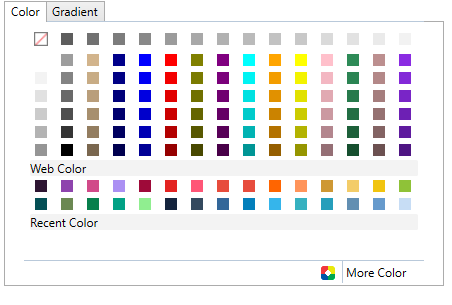
Shows you different color options to choose from.
6 Gradient Tab

You can find different gradient options to choose from. To know more about gradients, see this.
7 Background Tab
![]()
Includes different options for the Color Tab and the Gradient Tab. You can use this to customize the background of the Scroll Up button.
8 Border Tab
![]()
It consists of the options to design the border. See this to know the border designing options.
9 Arrow Background Tab

Find many color options for the button’s arrow.
10 Arrow Border Tab
![]()
Provides you with different color options for the border. And also gives you the option to change its thickness also.
11 Layout Tab
![]()
Use the Layout Tab to modify the height and width of the Scroll Up button.

1 Specify Admin Email
![]()
In this field, specify the admin email address on which the messages will be sent. For example, if you want all the messages to be sent on your email address, then fill in your email address in this field.
2 Set Margin

You can set a custom margin of Contact form from all the sides. The margin will be the same from all sides if the” Select All” option is checked. Uncheck ” Select All” to specify different margin for all sides i.e. Top, Bottom. Left, & Right.
3 Contact Form fields

These Contact Form Fields are added by default. You can add more fields as needed.
4 Apply Validation Rule

Click the drop down arrow and select a validation rule for the field. There are four option to select the validation rule as No Validation, Email, Numeric, and URL. Validation text lets you provide a message to help the users whose input data that is not correct.
5 Required Field
![]()
This icon signifies that the particular field is mandatory. To make a field mandatory, just click the “star icon” shown besides the field.
6 Add New Field
![]()
Click on this button to add a new field in your contact form.
7 Delete
![]()
Use this option you can delete the contact form field.
8 Typography Tab
![]()
From this tab, you can change the text style of the labels used in the contact form.
9 Button Tab
![]()
Lets you select the type of the button you want to use on your contact form.
10 Message Field
![]()
It facilitates a message box in the contact form that provides a text area for the user to write the message.
11 Enable Attachments

If enabled, the Enable Attachments option allows the user to attach the file with restricted extensions using the Browse button option. And also mention the size of the attachment as specified by you in the corresponding fields. You will also be able to define the Browser typography if Enable Attachment is checked as shown below:

12 OK
![]()
Click on the OK button to add the contact form in the template/website with changes applied.
13 Cancel
![]()
Use the Cancel option to rule out all of the changes and close the dialog box.